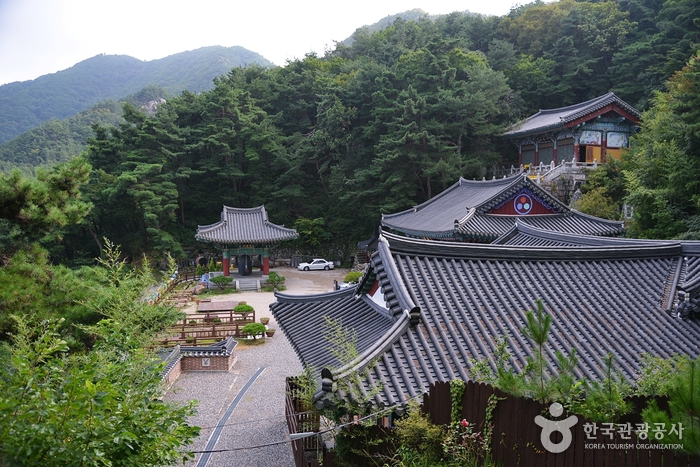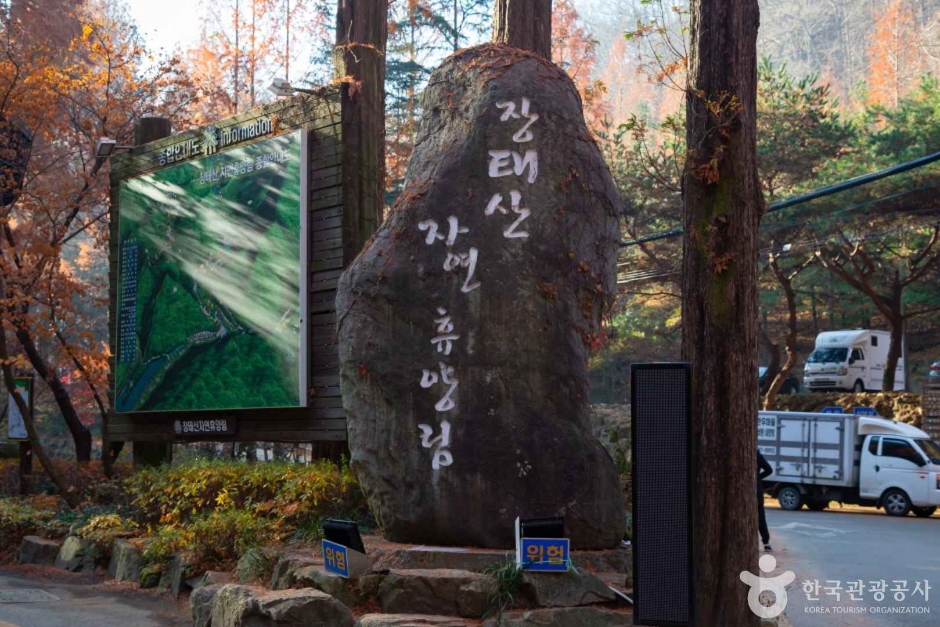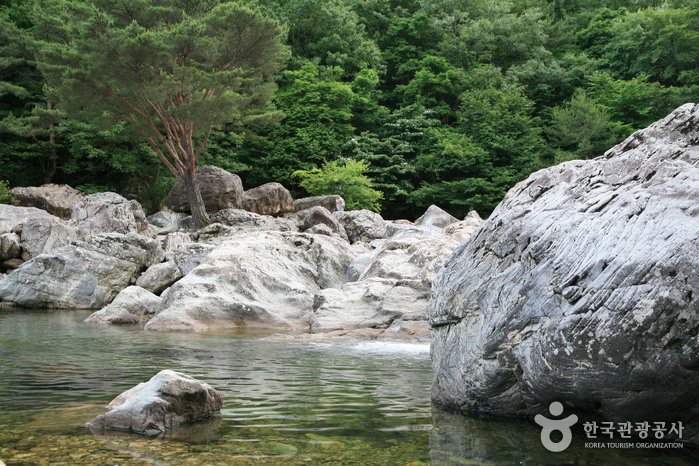Daedunsan Provincial Park (Jeollabuk-do Section) (대둔산도립공원(전북))
14.1Km 2024-04-07
611-34, Sanbuk-ri, Wanju-gun, Jeonbuk-do
+82-63-263-9949
Daedunsan Mountain is defined by the grandiose rock peaks of Macheondae Summit, Chilseongbong, Janggunbong, and Ambong Peaks, as well as surrounding strange rocks and lush trees that fill the area including Samseonbawi Rock, Yongmungol Valley and Geumgangmun Gate. The area spanning from Macheondae Peak to Nakjodae Peak along the northern ridge offers a magnificent view, especially of the sunrise and sunset from Nakjodae.
Since its designation as a provincial park in 1977, Daedunsan Provincial Park has served as a scenic site equipped with recreational facilities including a cable car and Geumgang Suspension Bridge. A 5-minute cable car ride followed by a walk up the steep stairs leads to the suspension bridge, stretching 50 meters from Imgeumbawi Rock to Ipseokdae Pedestal. The park is also home to historic temples including Taegosa Temple of Jinsan, Ansimsa Temple of Unju, and Sinsounsa Temple of Byeolgok.
Yeongdong Bidangang Forest Village (영동 비단강숲마을)
14.8Km 2025-01-14
20-27, Sudu 1-gil, Yangsan-myeon, Yeongdong-gun, Chungcheongbuk-do
+82-43-745-5432
Yeongdong Bidangang Forest Village is a pure farming village which was at the historical border between the Silla and Baekje kingdoms. Also located nearby is Yeongguksa Temple, where King Gongmin escaped from the Red Turban troops during the Goryeo period.
Created by the Geumgang River that flows like silk around Bonghwasan Mountain, the village is surrounded by breathtaking scenery, keeping Mother Nature clean so organisms including marsh snails and mandarin fish can live.
In the village, plenty of hands-on activities such as catching snails in the crystalline water like a treasure hunter and riding a tandem
bike are available to make a valuable memory. Not only these activities, visitors can also take a rest within the ambience of Bidangang River and pick sweet potatoes and grapes, giving the pleasure of harvesting. Other programs including making a wooden doorplate, wine foot-bathing, flying a pungdeung (lantern), and herb soap-making are offered.
Okcheon Yongamsa Temple (용암사(옥천))
15.7Km 2022-12-27
400, Samcheong 2-gil, Okcheon-gun, Chungcheongbuk-do
+82-43-732-1400
Yongamsa Temple, located in the mid-slope of Jangyongsan Mountain, is a branch of Beopjusa Temple. It was built during the Silla period. Unlike the more common temple arrangements, the stone pagoda in Yongamsa is uniquely situated on a low peak in the north with a view on all sides. The East and West Three-story Stone Pagodas of Yongamsa Temple, a designated Treasure, can be found here, as well as Rock-caved Buddha, and Wooden Seated Amitabha Buddha in Daeseongjeon Hall.
Jangtaesan Recreational Forest (장태산자연휴양림)
16.5Km 2024-12-02
461 Jangan-ro, Seo-gu, Daejeon
Jangtaesan Recreational Forest consists of a dense forest of ginkgo trees and bald cypress. Lush valleys nearby make for a great getaway during summer vacation. Yongtaeul Reservoir, located at the entrance, gives beautiful views as well. Inside the natural recreation forest, various facilities including walking paths, physical activity facilities, a botanical garden and bare-foot walking paths are available for visitors.
Daedunsan Provincial Park (Nonsan Section) (대둔산도립공원 (논산))
16.7Km 2024-07-09
Surakgyegok-gil, Nonsan-si, Chungcheongnam-do
+82-41-746-6156
Daedunsan Mountain offers spectacular views and various scenic spots like Gunjigyegok Valley, Surakpokpo Falls, Macheondae Seonnyeopokpo Falls, Nakjodae Peak, Surakgyegok Valley, and more. In particular, the one-kilometer-high cliff and the unique rock formations at Surakpokpo Falls provide great scenery.
Surakpokpo Falls and Gunjigyegok Valley are at the entrance of the hiking trail that leads up to Daedunsan Mountain. It is about a two-hour hike from Surakgyegok Valley to Macheondae Peak on Daedunsan Mountain.
Surakgyegok Valley (수락계곡)
16.8Km 2024-02-21
116 Surak-ri, Beolgok-myeon, Nonsan-si, Chungcheongnam-do
Surakgyegok Valley is a valley located in the northern part of Daedunsan Provincial Park. Enveloped by forests and flowing streams, it offers opportunities for forest bathing, and its moderate temperatures even in the summer make it suitable for leisure activities. Throughout the valley, visitors can find waterfalls such as Surakpokpo Falls and Seonnyeopokpo Falls. A notable feature of this area is the steep iron staircase nestled between cliffs, leading from the valley to the summit of Daedunsan Mountain, which is a highlight of the area.
Jeongjanamu Garden (정자나무가든)
17.8Km 2024-02-15
226 Jangan-ro, Seo-gu, Daejeon
Jeongjanamu Garden is a restaurant that serves traditional Korean homestyle meals. When ordering the signature dish cheonggukjang ssambap (rich soybean paste stew, leaf wraps and rice), customers are served with cheonggukjang (rich soybean paste), jeyukbokkeum (spicy stir-fried pork), and nine varieties of side dishes. Diners can enjoy a Korean dining experience by wrapping rice and side dishes in fresh leafy greens and savoring a spoonful of the hearty cheonggukjang. Additionally, the restaurant offers grilled Korean beef and pork.
Muju Rafting (무주래프팅)
17.8Km 2024-04-07
5-11, Jamdu-gil, Muju-gun, Jeonbuk-do
+82-63-322-7745
Muju Rafting resort is located on the upper Geumgang River and offers rafting, survival game, hiking, and fishing programs. The area is over 9,900 ㎡ in size and can accommodate lodging for up to 200 guests.
Byeolcheonji Sikdang (별천지식당)
18.1Km 2024-02-15
29 Sanseo-ro 1659beon-gil, Dong-gu, Daejeon
Byeolcheonji Sikdang is a Korean nutritious food restaurant renowned for its specialization in baeksuk (whole chicken soup). Their standout dish is oribaeksuk (whole duck soup), meticulously prepared with cordyceps and a blend of traditional medicinal herbs to enrich both its flavor and health benefits. Additionally, the restaurant is acclaimed for its baeksuk made with native chicken and galbi tang (galbi soup). Set next to a serene pond, Byeolcheonji Sikdang provides a peaceful atmosphere for guests to enjoy their meals.
Uniram Baniramgyegok Valley (운일암 반일암 계곡)
18.7Km 2025-01-10
1926, Dongsangjucheon-ro, Jucheon-myeon, Jinan-gun, Jeonbuk-do
+82-63-430-8382
Uniram Baniramgyegok Valley (5 km long) falls between Myeongdeokbong Peak and Myeongdobong Peak in the northeastern region of Mount Unjangsan. The name Uniram refers to the steep walls of the valley where nothing but the sky, rocks, thick forests, and clouds can be seen. The valley is also befittingly named Baniram since it is so deep that it only receives direct sunlight for half the day. There are many strangely-shaped rocks like Jjokduri Rock, Cheollyeop Rock, and Daebul Rock scattered throughout the lush valley. At the peak of summer, the area is crowded with vacationers and is also popular for its autumn leaves.




 English
English
 한국어
한국어 日本語
日本語 中文(简体)
中文(简体) Deutsch
Deutsch Français
Français Español
Español Русский
Русский